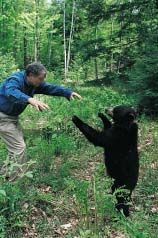 |
 |
| current issue |  |
past issues |  |
send a letter/news |  |
address update |  |
advertise |  |
about us |  |
alumni home |
Features
The Bear EssentialsPage 3 of 4
"Any animal with a long dependency probably has a lot to learn," he said as we walked with the cubs. "There must be a certain amount of knowledge they are born with, but other things they have to discover or learn--like the Indian cucumber. The only way they can do that is by being out here in the woods."
 An 18-month-old Yoda initiates the ritualized wrestling that black bears use when meeting and greeting other bears. Photo by Robert Caputo |
The success of his technique seemed pretty obvious. The little cubs had been trailing along behind us for a while, occasionally stopping to sniff the ground or the bushes. When we sat down, the cubs took to the woods, chasing each other, tearing apart rotting logs to look for ants and grubs, scampering up trees. They never went too far from us, but Kilham's presence seemed to give them the security they needed to set off, tentatively, on their own.
"Every time I come out here with the bears I learn something just by watching them," Kilham said. "I've noticed, for example, that the cubs hold plants in their mouths before they eat or discard them. They must have some kind of chemo-receptors that analyze the plants and let them know if they're edible. And when they first come out of hibernation, they search diligently for moose and deer scat. They seem to need the bacteria to get their systems going again. If you don't know this, you can feed them all you want, but it's not going to do much good."
The real test of his rehabilitation method, though, is not how healthy his cubs are or how freely they romp in the woods. What kind of adults will they turn out to be? Will they be able to survive as wild bears?
"A lot of other rehabilitators thought my cubs would become nuisance bears because I raised them in this friendly way. They would not be afraid of people and in fact would seek them out for food. But bears are smarter than that. It's not people they have gotten to know, it's me, as an individual."
To prove his point, Kilham took me to visit Squirty, a 3-year-old female who was living in the woods outside of Lyme. She and her brother and sister had been orphaned, and Kilham had raised them much as he was raising Yoda and Houdini. Squirty was now grown up, with two cubs of her own, and seemed to be thriving in the wild.
We drove several miles from Lyme, got on three-wheelers to negotiate an old logging road, then hiked quite a way into the woods. As we walked, Kilham pointed out what he called "bear trees" to me.
"This is one of the many things I've learned from Squirty and her siblings," he said. "Trees like this red pine are the equivalent of bear bulletin boards. If we had a bear's sense of smell, we would know which bears have been here and when. You can see the teeth marks from where they've been biting the tree and leaving their scents."
MORE ABOUT THE BEARS To learn more about Ben Kilham and his bears, read his new book,
Among the Bears: Raising Orphaned Cubs in the Wild
, published last spring by Henry Holt. In it Kilham documents the bears' event-filled journey from ophaned cubs to adults. The book was coauthored by Ed Gray, a founding editor of Gray's Sports Journal.
To learn more about Ben Kilham and his bears, read his new book,
Among the Bears: Raising Orphaned Cubs in the Wild
, published last spring by Henry Holt. In it Kilham documents the bears' event-filled journey from ophaned cubs to adults. The book was coauthored by Ed Gray, a founding editor of Gray's Sports Journal.
|
Kilham is convinced that bears are primarily olfactory animals and that they communicate with each other by leaving scent deposits in seemingly mutually agreed-upon places. Females can advertise their reproductive state, and males can announce to females that they are around and warn other males to stay away. They may even leave messages about the availability of food. Other naturalists have observed bears rubbing on trees, but because his bears tolerate Kilham's presence so calmly, he has been able to decipher the reason for the behavior.
"Watching bears in the wild is extremely difficult unless you have a relationship with them," he explained. "Wild bears become nervous when people are around, so you're not likely to see much natural behavior. My guys just ignore me and go on about their business. Come on--she's just up here."
Approaching cute little cubs is one thing. Walking up to a fully-grown wild mother bear with cubs to protect is quite another. As we neared, Kilham called out to let Squirty know who was coming. I heard a rapid whooshing sound as she warned her cubs and then the scrape of little claws scampering up a tree to safety. I followed Kilham as he walked straight toward Squirty.
"You'd better stay here," he said as we drew close. I was only too happy to oblige.
Page: < Prev 1 2 3 4 Next >Easy to print version

